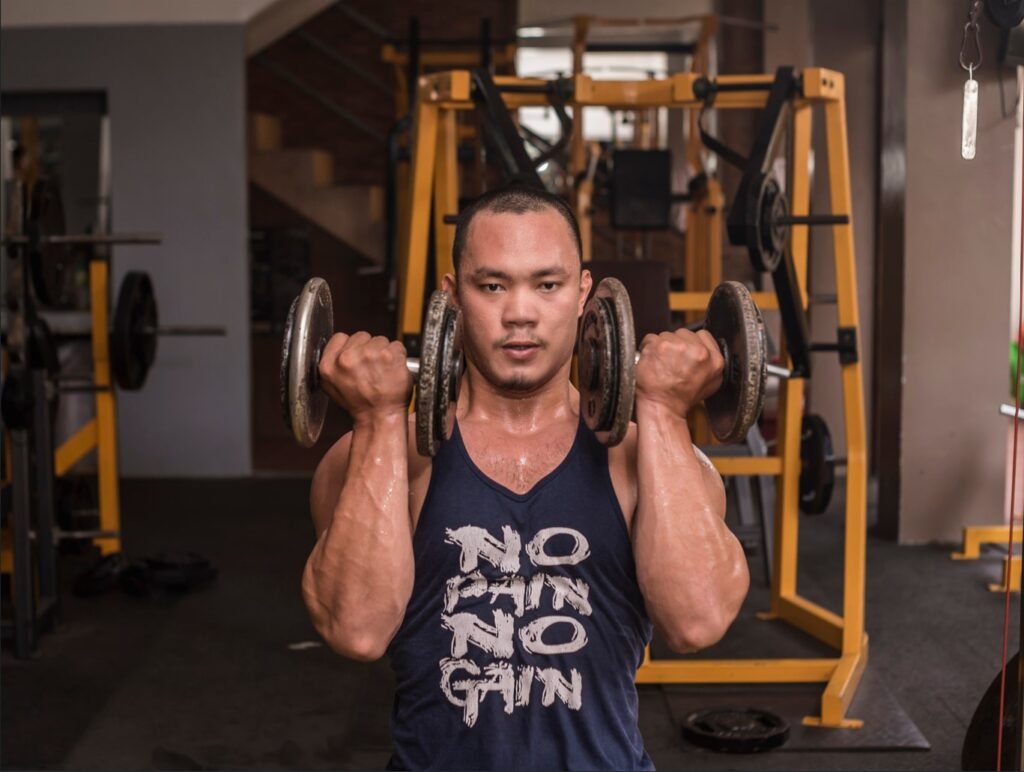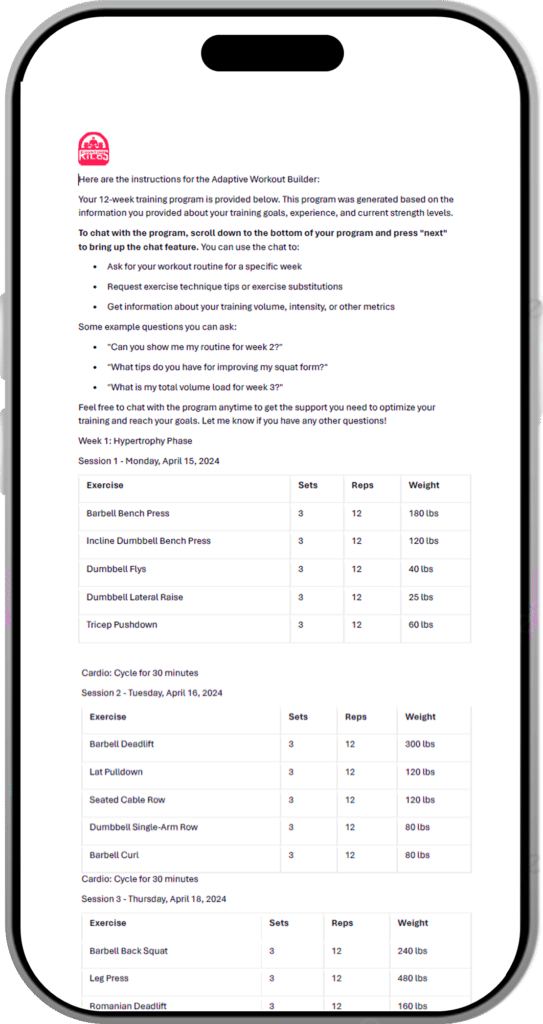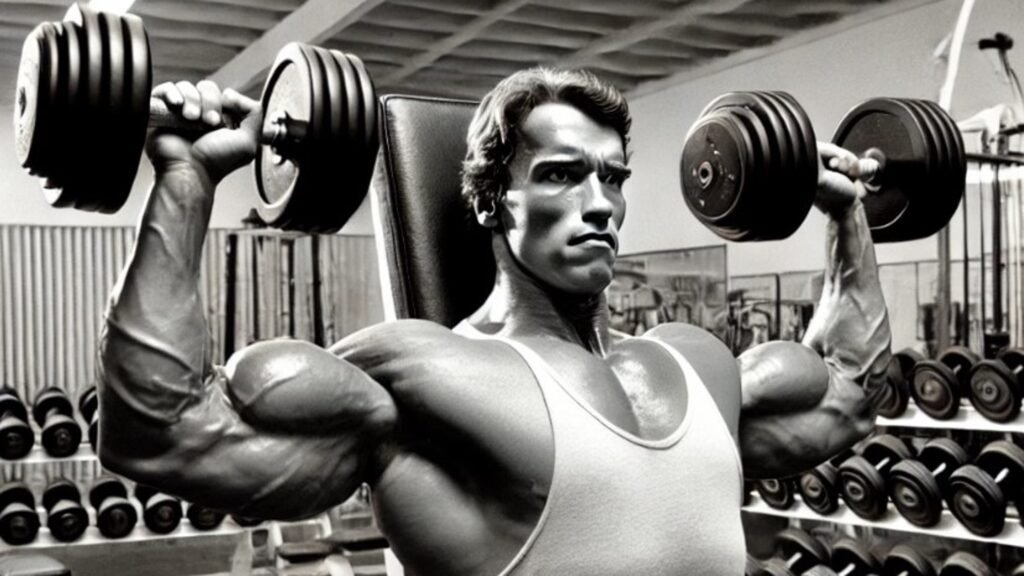In the ever-evolving world of strength training, certain exercises have withstood the test of time, proving their effectiveness time and time again. The seated Arnold press is one such exercise, a true classic that has been sculpting impressive shoulders for decades. Named after the legendary Arnold Schwarzenegger himself, this movement is a must-have in any serious lifter’s arsenal.
Moreover, whether you’re a seasoned bodybuilder or a fitness enthusiast seeking that coveted V-taper, the seated Arnold press is a game-changer. So, buckle up and get ready to unlock the secrets of this shoulder-shaping sensation.
Key Takeaways:
- The seated Arnold press targets all three deltoid heads, along with secondary muscles like the triceps and upper chest.
- The exercise’s rotational component sets it apart from standard shoulder presses, potentially leading to increased muscle activation.
- Proper form and technique are crucial for maximizing benefits and minimizing injury risk.
- The seated variation offers increased stability compared to standing versions, allowing for better isolation of the shoulder muscles.
- Progressive overload and variation in equipment and execution can help continually challenge the muscles and promote growth.
Now, let’s break down this shoulder-shaping exercise and see why it deserves a prime spot in your workout routine.
Proper Technique and Form
Starting Position
Alright, let’s set the stage for your shoulder showdown. First things first, find yourself a sturdy bench – we’re not looking for a wobbly situation here. Sit your posterior down with your feet flat on the floor, shoulder-width apart. Engage that core like you’re bracing for a punch from Mike Tyson (don’t worry, it’s just an analogy).
Grab a dumbbell in each hand and bring them up to shoulder level. Here’s where things get interesting: start with your palms facing your face, as if you’re admiring your biceps in a mirror (we’ve all been there). Your elbows should be bent and pointing out to the sides, creating that classic “goalpost” position.

Remember, maintaining proper posture is key. Keep that back straight and those shoulder blades retracted. Think of it as trying to pinch a pencil between your shoulder blades – minus the actual pencil, of course.
Execution of the Movement
Now for the main event. Here’s your step-by-step guide to performing the perfect seated Arnold press:
- From the starting position, begin pressing the dumbbells overhead.
- As you press up, rotate your palms so they face forward at the top of the movement.
- At the top, your arms should be fully extended overhead, forming a “Y” shape with your body.
- Pause briefly at the top, feeling that sweet shoulder burn.
- Lower the weights back down to the starting position, reversing the movement.
- As you lower, rotate your palms back towards your face.
- Return to the starting position and repeat.
The key to this exercise lies in the rotational aspect. It’s not just about pressing the weight up; it’s about that smooth, controlled rotation that makes the Arnold press unique. Think of it as doing the twist, but with your arms and some heavy dumbbells.
As for breathing, inhale as you lower the weights and exhale as you press up. It’s like blowing out birthday candles, except instead of cake, you’re rewarded with sculpted shoulders.
Range of motion is crucial here. Aim to lower the dumbbells until your upper arms are parallel to the floor, then press all the way up until your arms are fully extended. However, if you have any shoulder issues, you might need to adjust your range of motion. Listen to your body – it usually knows what it’s talking about.
Common Mistakes and How to Avoid Them
Even the most seasoned lifters can fall prey to form faux pas. Here are some common mistakes to watch out for:
- Overarching the back: This isn’t a limbo contest. Keep that lower back pressed against the bench.
- Using momentum: The seated Arnold press is not a full-body dance move. Control the weight throughout the entire movement.
- Incorrect dumbbell path: The dumbbells should move in an arc, not straight up and down. Think rainbow, not elevator.
- Neglecting the rotational component: This is what makes the Arnold press special. Don’t forget to rotate those wrists!
- Letting the elbows drop: Keep those elbows up and out to the sides throughout the movement. Dropping them reduces the effectiveness of the exercise and can put unnecessary strain on your shoulders.
Remember, form is king (or queen, we don’t discriminate in the gym). Also, it’s better to lift lighter weights with perfect form than to heave heavy dumbbells around like a caveman. Trust me, your shoulders will thank you in the long run.

Variations and Progressions
Equipment Alternatives
While the classic seated Arnold press is typically performed with dumbbells, variety is the spice of life – and muscle growth. Let’s explore some equipment alternatives that can add a new twist to this shoulder-sculpting exercise:
- Kettlebells: These cannonball-with-a-handle weights can add an extra stability challenge to your Arnold press. The offset weight distribution forces your stabilizing muscles to work overtime, potentially leading to greater overall shoulder development. Just be prepared for some interesting looks from the “dumbbells-only” crowd.
- Resistance Bands: Don’t underestimate these colorful rubber bands. Resistance bands provide constant tension throughout the entire range of motion, which can be particularly beneficial for muscle activation and endurance. Plus, they’re perfect for those days when you want to feel like you’re in an 80s workout video.
- Cable Machine: The cable machine is like the Swiss Army knife of gym equipment. For the Arnold press, it offers constant tension and allows for a variety of angles and positions. You can perform the exercise seated or standing, and even do unilateral (one-arm) variations. It’s like having a personal shoulder-sculpting robot at your disposal.
Here’s a quick comparison table of these equipment alternatives:
| Equipment | Pros | Cons |
|---|---|---|
| Dumbbells | Classic, widely available, easy to progress | Can be challenging to get into starting position with heavy weights |
| Kettlebells | Adds stability challenge, unique grip | May be harder to find matching pairs, less common in gyms |
| Resistance Bands | Portable, constant tension, joint-friendly | May not provide enough resistance for advanced lifters |
| Cable Machine | Constant tension, variety of angles | Requires access to a cable machine, can be busy in commercial gyms |
Seated Arnold Press Variations
Now that we’ve covered equipment alternatives, let’s dive into some variations of the seated Arnold press that can spice up your shoulder routine:
- Single-arm Arnold Press: This unilateral variation allows you to focus on one side at a time, potentially addressing muscle imbalances and improving stability. It’s like the solo career of a boy band member – sometimes it’s better when they go it alone.
- Incline Bench Arnold Press: By performing the Arnold press on an incline bench, you shift the emphasis slightly to the front delts and upper chest. This variation is perfect for those looking to build that coveted “shelf” look in the upper chest and shoulders.
- Stability Ball Seated Arnold Press: Take a seat on a stability ball and prepare for a core-crushing, shoulder-building extravaganza. This variation adds an extra balance challenge, forcing your core to work overtime to keep you stable. It’s like trying to do shoulder presses while riding a mechanical bull – minus the country music and cowboy hats.
Progressive Overload Strategies
Progressive overload is the name of the game when it comes to building strength and muscle mass. Here are some strategies to keep your shoulders guessing and growing:
- Increasing weight incrementally: The most straightforward approach. Gradually increase the weight you’re lifting as you get stronger. Just remember, we’re aiming for progress, not a shoulder impingement.
- Adjusting rep ranges and sets: Mix it up by altering your rep ranges and set numbers. One week you might do 3 sets of 8-10 reps, the next week 4 sets of 6-8 reps. It’s like changing the difficulty settings on a video game, except the boss level is always your own limitations.
- Tempo manipulation: Slow down the eccentric (lowering) phase of the movement or add pauses at different points in the range of motion. This increases time under tension, which can lead to greater muscle growth. Think of it as slow-motion shoulder sculpting.
- Drop sets and supersets: For the masochists among us, drop sets (reducing weight and continuing to rep out) and supersets (pairing Arnold presses with another shoulder exercise) can provide an extra challenge and stimulus for growth. Just be prepared for some serious shoulder pump and potential T-rex arm syndrome post-workout.
Remember, the key to progressive overload is, well, progress. Keep track of your weights, reps, and sets, and strive to improve over time. Rome wasn’t built in a day, and neither are boulder shoulders.

Adaptive Workout Builder
STOP WASTING YOUR TIME WITHOUT A PLAN
- Personalized training programs based on user input.
- Customizable workouts targeting specific goals.
- Dynamic adjustments to workouts as progress is tracked.
- Options to request technique tips and exercise substitutions.
- Insights into training volume, intensity, and other metrics.
Programming the Seated Arnold Press
Incorporating into Your Workout Routine
Now that we’ve covered the nuts and bolts of the seated Arnold press, let’s talk about how to seamlessly integrate this shoulder-sculpting move into your workout routine. Like a well-orchestrated symphony (or a perfectly curated playlist for you youngsters), the placement of the Arnold press in your workout can make or break its effectiveness.
For beginners, I recommend incorporating the seated Arnold press into your routine 1-2 times per week. As you progress and your shoulders start to resemble cannonballs, you can bump it up to 2-3 times per week.
Ideally, you want to place the Arnold press early in your shoulder or upper body workout when your muscles are fresh and ready to take on the world (or at least some heavy dumbbells). Here’s a sample shoulder workout that incorporates the seated Arnold press:
- Seated Arnold Press: 3-4 sets of 8-12 reps
- Lateral Raises: 3 sets of 12-15 reps
- Front Raises: 3 sets of 12-15 reps
- Reverse Flyes: 3 sets of 12-15 reps
- Shrugs: 3 sets of 15-20 reps
Remember, this is just a template. Feel free to adjust based on your fitness level, goals, and how much you enjoy feeling like your shoulders are on fire.
Sets, Reps, and Rest Periods
The age-old question: how many sets and reps should I do? Well, like most things in life, it depends on your goals. Are you looking to build the Incredible Hulk’s shoulders, or are you more interested in endurance for all those high-fives you’ll be dishing out with your newly sculpted delts?
For hypertrophy (muscle growth):
- Sets: 3-4
- Reps: 8-12
- Rest between sets: 60-90 seconds
For strength:
- Sets: 4-5
- Reps: 4-6
- Rest between sets: 2-3 minutes
For endurance:
- Sets: 2-3
- Reps: 15-20
- Rest between sets: 30-45 seconds
Remember, these are guidelines, not commandments etched in stone. Listen to your body and adjust accordingly. If you’re feeling like a superhero, push a little harder. If you’re feeling more like a wet noodle, dial it back a notch.
Complementary Exercises
The seated Arnold press is great, but like peanut butter without jelly or Batman without Robin, it’s incomplete without some complementary exercises. Here are some moves that pair well with the Arnold press to create a well-rounded shoulder routine:
- Lateral Raises: These target the lateral deltoids, giving you that coveted shoulder width. Pair these with Arnold presses for a double whammy of delt destruction.
- Face Pulls: An often-overlooked exercise that targets the rear deltoids and rotator cuff muscles. These are crucial for shoulder health and balance.
- Upright Rows: Another compound movement that hits the front and lateral deltoids, as well as the traps.
- Reverse Flyes: These isolate the rear deltoids, helping to balance out all the pressing movements.
- Overhead Press: The classic shoulder press complements the Arnold press by allowing you to push heavier weights in a more stable position.
Remember, a balanced shoulder routine should include exercises that target all three heads of the deltoid (front, lateral, and rear), as well as the supporting muscles like the rotator cuff and traps. It’s like assembling the Avengers of shoulder exercises – each one brings something unique to the table.
To create a full shoulder routine, try this superset structure:
- Seated Arnold Press + Face Pulls
- Lateral Raises + Reverse Flyes
- Upright Rows + Shrugs
Perform 3-4 sets of each superset, with minimal rest between exercises and 60-90 seconds rest between supersets. It’s like circuit training for your shoulders – efficient, effective, and guaranteed to leave you feeling like you’ve been hugged by a giant.
Remember, balance is key. Don’t neglect your pulling movements in favor of all this pressing. Incorporate exercises like rows and pull-ups into your routine to maintain shoulder health and prevent imbalances. Your shoulders (and your posture) will thank you.

Safety Considerations and Injury Prevention
Warm-up and Mobility Work
Alright, listen up, because this part is crucial. Jumping into a shoulder workout without a proper warm-up is like trying to run a marathon right after waking up from a nap – it’s a recipe for disaster (and possibly some very confused onlookers).
Start with some light cardio to get the blood flowing. A few minutes on the rowing machine or some jumping jacks will do the trick. Think of it as waking up your muscles from their slumber, minus the coffee.
Next, let’s focus on shoulder-specific warm-ups:
- Arm circles: Start small and gradually increase the size of the circles. Forward and backward, like you’re trying to draw the world’s roundest circles with your fingertips.
- Shoulder rolls: Roll those shoulders forward and backward. It’s like you’re shrugging off the weight of the world, or at least the weight of your impending workout.
- Wall slides: Stand with your back against a wall and slide your arms up and down. It’s like making snow angels, but vertical and without the snow.
- Band pull-aparts: Grab a resistance band and pull it apart in front of you. Imagine you’re trying to stretch a really stubborn rubber band.
- Scapular push-ups: These aren’t your regular push-ups. Focus on moving your shoulder blades without bending your elbows. It’s like you’re trying to pinch a penny between your shoulder blades.
For the rotator cuff, try these exercises:
- Internal and external rotations: Use a light resistance band or dumbbell. It’s like you’re opening and closing a really heavy door, but with your arm at your side.
- Empty cans: Hold light dumbbells and raise your arms to the side with thumbs pointing down. You’ll look like you’re pouring out two cans of soda, hence the name.
Remember, the goal of the warm-up is to prepare your body for the workout, not to exhaust yourself before you even start. Keep it light and focus on movement quality rather than quantity.
Recovery and Injury Prevention
After you’ve annihilated your shoulders with Arnold presses and complementary exercises, it’s time to focus on recovery. Think of it as the encore to your shoulder-shredding performance.
Start with some light stretching or foam rolling to help alleviate muscle soreness and promote blood flow. Spend extra time on the deltoids, rotator cuff, and upper back muscles. It’s like giving your shoulders a well-deserved massage after their grueling workout.
Don’t forget to hydrate and refuel with a balanced post-workout meal or shake. Your muscles need the proper nutrients to recover and grow. Aim for a mix of protein, carbohydrates, and healthy fats. It’s like giving your shoulders a standing ovation with every bite.
Additionally, rest days are equally important. Overtraining can lead to injury and hinder progress, so make sure to schedule at least one or two full rest days per week. Use this time to catch up on your favorite Netflix series or engage in some light active recovery activities like walking or stretching.
If you experience persistent pain or discomfort, don’t hesitate to seek medical advice. It’s better to address potential issues early on rather than pushing through and risking more severe injuries. Your shoulders are precious cargo, and you don’t want to jeopardize their performance.
Advanced Tips for Maximizing Results
Mind-Muscle Connection
Alright, you’ve mastered the technique, variations, and programming. Now it’s time to take your shoulder game to the next level with some advanced tips for maximizing results.
First up, the mind-muscle connection. This elusive concept is the key to unlocking true muscle activation and growth. It’s like having a direct line of communication between your brain and your deltoids, allowing you to control the contraction and target the muscles more effectively.
Here are some techniques to improve your mind-muscle connection during the seated Arnold press:
- Visualization: Before you even pick up the dumbbells, visualize the movement in your mind. Imagine the muscles contracting, the weights moving through the full range of motion, and the rotational aspect of the exercise. It’s like creating a mental blueprint for your shoulders to follow.
- Squeeze at the top: As you reach the top of the movement, focus on squeezing your deltoids as hard as you can. Imagine you’re trying to crush a grape between your shoulder and ear. This conscious contraction will help reinforce the mind-muscle connection.
- Slow and controlled: Resist the urge to rush through the movement. Slow down the eccentric (lowering) phase and focus on feeling the muscles work through the entire range of motion. Essentially, it’s like savoring every bite of your favorite meal, but with weights instead of food.
- Cue yourself: Use verbal cues to remind yourself to engage the target muscles. As you press up, say “squeeze” or “contract” to yourself. Also, it might seem silly, but it can help reinforce the mind-muscle connection.
Remember, building the mind-muscle connection takes practice and patience. It’s like learning a new language – the more you immerse yourself in it, the more fluent you’ll become.
Nutrition for Shoulder Development
Proper nutrition is the foundation upon which all muscle-building efforts are built. Without the right fuel, your shoulders will struggle to grow and recover, no matter how perfectly you execute the Arnold press.
Here are some key nutritional considerations for optimal shoulder development:
- Protein: This macronutrient is essential for muscle growth and repair. Aim for 0.7-1 gram of protein per pound of body weight, spread evenly throughout the day. Good sources include lean meats, eggs, dairy, and plant-based options like beans and quinoa.
- Carbohydrates: Carbs provide the energy your muscles need to power through intense workouts. Focus on complex carbs like whole grains, fruits, and vegetables for sustained energy and fiber.
- Healthy fats: Don’t fear the fat! Healthy fats from sources like avocados, nuts, and fatty fish are essential for hormone production, joint health, and overall recovery.
- Micronutrients: Vitamins and minerals like zinc, magnesium, and vitamin C play crucial roles in muscle growth, repair, and overall shoulder health. Load up on nutrient-dense foods or consider a quality multivitamin.
Timing your meals around your workouts can also be beneficial. Aim to consume a mix of protein and carbs within 30-60 minutes after your shoulder session to kickstart the recovery process.

Supplementation
While a balanced diet should be your primary source of nutrients, strategic supplementation can provide an extra edge in your pursuit of boulder shoulders. Here are some supplements that may support shoulder development and recovery:
- Creatine: This well-researched supplement can increase muscle strength, power, and size. It’s like giving your shoulders a legal performance-enhancing boost.
- Whey protein: A high-quality whey protein powder can help you meet your daily protein needs, especially on those busy days when meal prep is a challenge.
- BCAAs: Branched-chain amino acids (BCAAs) can help reduce muscle breakdown and support recovery, making them a valuable addition to your post-workout routine.
- Fish oil: The omega-3 fatty acids in fish oil can help reduce inflammation and support joint health, which is crucial for maintaining shoulder mobility and preventing injuries.
- Vitamin D: Many people are deficient in this essential vitamin, which can negatively impact muscle growth and recovery. Consider supplementing, especially during the winter months or if you don’t get much sun exposure.
Remember, supplements should never replace a balanced diet. Always consult with a healthcare professional before starting any new supplement regimen, especially if you have any underlying health conditions or are taking medications.
Conclusion
Recap of Key Points
Congratulations, you’ve made it to the end of this comprehensive guide to mastering the seated Arnold press! Let’s quickly recap the key points we’ve covered:
- The seated Arnold press is a shoulder-sculpting exercise that targets all three deltoid heads, as well as the triceps, upper chest, and trapezius.
- Proper form and technique are crucial for maximizing results and minimizing injury risk. Pay close attention to details like posture, range of motion, and the rotational component.
- Progressive overload strategies like increasing weight, adjusting rep ranges, and incorporating variations can help continually challenge your muscles and promote growth.
- Programming the Arnold press into a well-rounded shoulder routine, along with complementary exercises, is essential for balanced development and injury prevention.
- Warm-up, mobility work, form checks, and recovery protocols are vital for maintaining shoulder health and longevity in the gym.
- Advanced tips like mastering the mind-muscle connection, optimizing nutrition, and strategic supplementation can take your shoulder gains to the next level.




helloI like your writing very so much proportion we keep up a correspondence extra approximately your post on AOL I need an expert in this space to unravel my problem May be that is you Taking a look forward to see you
Hello my loved one I want to say that this post is amazing great written and include almost all significant infos I would like to look extra posts like this
I just could not leave your web site before suggesting that I really enjoyed the standard information a person supply to your visitors Is gonna be again steadily in order to check up on new posts
Fantastic site Lots of helpful information here I am sending it to some friends ans additionally sharing in delicious And of course thanks for your effort